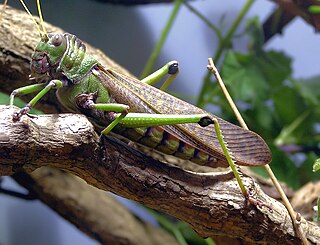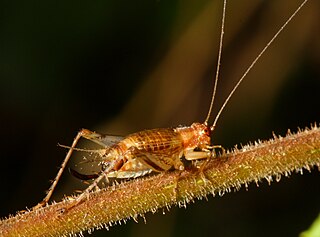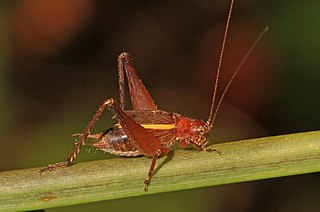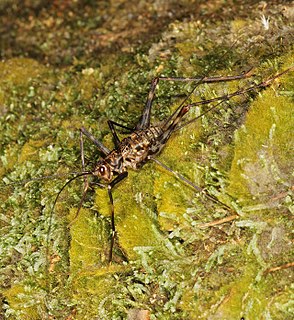
Conocephalus is a genus of bush-crickets, known as coneheads. It was described by Carl Peter Thunberg in 1815.

The family Fulgoridae is a large group of hemipteran insects, especially abundant and diverse in the tropics, containing over 125 genera worldwide. They are mostly of moderate to large size, many with a superficial resemblance to Lepidoptera due to their brilliant and varied coloration. Various genera and species are sometimes referred to as lanternflies or lanthorn flies, though they do not emit light.

The Romaleidae or lubber grasshoppers are a family of grasshoppers, based on the type genus Romalea. The species in this family can be found in the Americas.

Gryllotalpa is a genus of insects in the mole cricket family Gryllotalpidae.

Trigonidiinae is a subfamily of insects in the order Orthoptera, suborder Ensifera, based on the type genus Trigonidium. They are often referred to as sword-tail crickets, winged bush crickets or trigs.

The subfamily Pseudophyllinae contains numerous species in the family Tettigoniidae, the katydids or bush crickets. Sometimes called "true katydids", together with the crickets of suborder Ensifera, they form part of the insect order Orthoptera which also contains grasshoppers.

The Phaneropterinae, the sickle-bearing bush crickets or leaf katydids, are a subfamily of insects within the family Tettigoniidae. Nearly 2,060 species in 85 genera throughout the world are known. They are also known as false katydids or round-headed katydids.

The Eneopterinae are a subfamily of crickets, in the family Gryllidae, based on the type genus Eneoptera. It is one of several groups widely described as "true crickets". Of the more than 500 species that make up this subfamily, most occur in moist, tropical habitats. These insects are medium to large and brown or gray in color. They eat plant leaves, flowers, and fruits and can occasionally cause economic damage. Their eggs are deposited in pith, bark, or wood. Eneopterinae show a great diversity in stridulatory apparatus, signals emitted, and associated behaviour.

Anaxipha is a genus of brown sword-tail cricket from tropical areas in the Americas, Africa, Asia, Australia and western Pacific islands.

The Copiphorini are a tribe of bush crickets or katydids in the family Tettigoniidae. Previously considered a subfamily, they are now placed in the subfamily Conocephalinae. Like some other members of Conocephalinae, they are known as coneheads, grasshopper-like insects with an extended, cone-shaped projection on their heads that juts forward in front of the base of the antennae.

Dysdercus is a widespread genus of true bugs in the family Pyrrhocoridae; a number of species attacking cotton bolls may be called "cotton stainers".

Conocephalinae, meaning "conical head", is an Orthopteran subfamily in the family Tettigoniidae.

Hapithinae is a subfamily of insects in the cricket family Gryllidae. It is one of several groups referred to in American English as "bush crickets", although this term can be confused with the Tettigoniidae.

Romaleinae is a subfamily of lubber grasshoppers in the family Romaleidae, found in North and South America. There are more than 60 genera and 260 described species in Romaleinae.
Epilampra is a genus of cockroach in the family Blaberidae. There are more than 70 described species in Epilampra.

Pseudomops is a genus of cockroach in the family Ectobiidae. There are more than 40 described species in Pseudomops.

Podoscirtinae is a subfamily of crickets in the family Gryllidae.

The Phalangopsidae are a recently reconstituted family of crickets, based on the type genus PhalangopsisServille, 1831 from South America. Priority for family-group names based on this genus dates from Blanchard's "Phalangopsites".
Euscyrtus is a genus of crickets in the subfamily Euscyrtinae. Species can be found mostly in Africa, Asia and Australia.

















